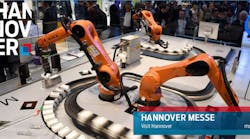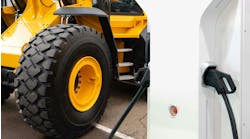Thousands of technically minded people converged on Hannover, Germany last month to see and learn about some of the newest technology in fluid power and other technologies at the Hannover Fair. I was fortunate enough to be among them. Of course, I saw dozens of high-tech displays and learned about some of the latest products. But what I saw at one booth really got my attention.
The Hannover Fair has more than 20 large exhibit halls, with different fields of technology being the focus in each. Several buildings contained dozens of companies exhibiting pneumatic equipment, and building 26 focused on air compressors. Walking one of the aisles, I saw a huge horizontal reciprocating compressor. This caught my attention because I became quite familiar with these big beasts more than 40 years ago in my first job in fluid power. I was assistant service manager for a power transmission and fluid power distributor, and much of my work involved coordinating service calls and ordering parts for different types of compressors. Quite a few of those were horizontals.
Horizontal compressors bear little resemblance to the reciprocating compressors you see in most service and repair shops. Instead, they often have a huge cylinder with a bore a foot or more in in diameter and a stroke to match. I remember one at a military contractor so big our service technician crawled inside to inspect the cylinder bore in preparation for having the entire machine rebuilt. It was an oil-less machine, so it wasn’t all that dirty, at least inside.
These machines remind me of antique hit-and-miss gas engines you often see at county fairs because they operate at a couple hundred rpm, if that. Although these compressors rotate at low speed, they still have high output because each stroke of that huge piston pushes out so much air with every stroke.
We serviced a lot of these machines because they seemed to last forever. However, I don’t think we ever sold any. Instead, the “smaller” compressors we sold (about 50 hp and lower) were the common reciprocating types you see everywhere. I even have a small one in my garage. The larger compressors we sold were oil-flooded rotary-screw units. They were all the rage back in the late 1970s and had all kinds of electronic controls to manage electrical power and air output.
Despite all these new innovations, the big, lumbering horizontals were theoretically more energy efficient. However, companies weren’t buying them because “total cost of ownership” had become new buzzwords. If you look only at energy-in vs. energy-out, horizontals were the most efficient machines around. But when you add in the maintenance and other peripheral costs, rotary screw machines had a lower total cost of ownership—or so I was told.
Again, most of this information is 40 years old. I hadn’t been around compressors much in the last few decades because they normally are specified for pneumatic systems. Instead, they are considered a capital expenditure.
I had assumed that companies no longer manufactured horizontal compressors. But it was at the booth for Ateliers Francois S.A., (better known as AF Compressors) that I saw a brand-new horizontal compressor. The rep at the booth recognized my surprise and listened intently as I explained what I’ve just written. His response was quite insightful.
He suggested that if I had not seen cars since the late 1970s, wouldn’t I be blown away at what I see now? Of course I would. He explained that the design of these compressors has not remained the same over the last 40 years. And even though they may not have advanced as much as cars have, maintenance and other operating costs have advanced these machines far beyond what I remember. He also mentioned that they are still the most effective way to produce clean compressed air with no residual oil. Rotary screws can produce oil-free air, but they are much less efficient.
It seemed fitting, then, that I fired up a selection of 70s music to listen to on my iPod for the streetcar ride back to my hotel.


